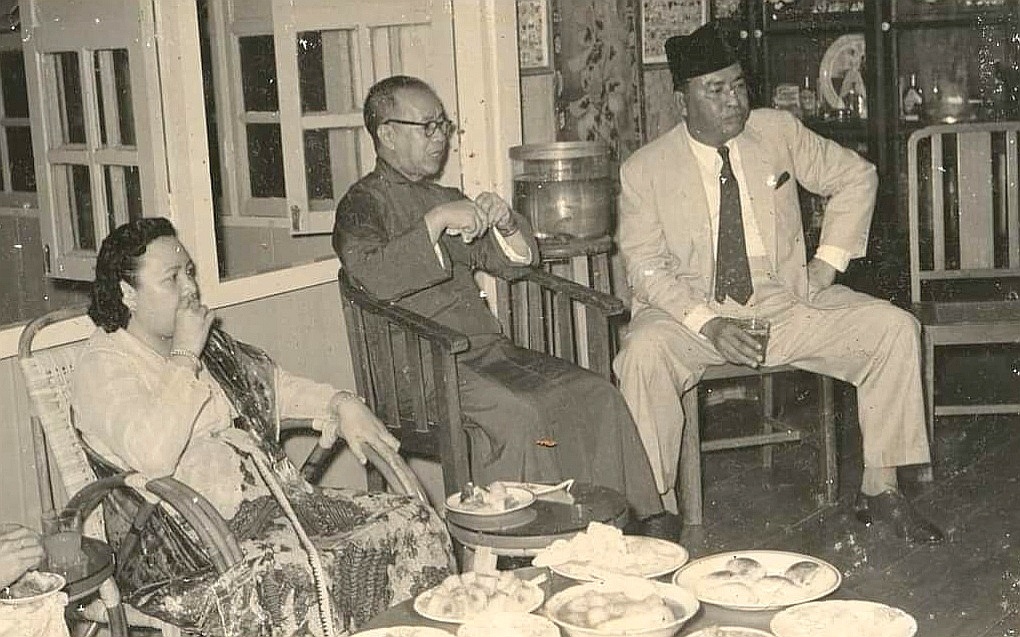
I HAVE very little recollection of my very early boyhood years before I had gone to school at age 6 in 1956. At best, I remember the celebrations during Chinese New Year (CNY) as my parents had taken me to visit my elders and other relatives from the year I was born – it was the custom then, and I believe it is still the tradition today.
Families really love to show off their offspring from as early an age as possible!
I must say that we did have a great many number of relatives to visit, both on my father’s and mother’s sides of the family. It was like an annual ritual, with a roster of whose house to go to first and then working downwards on the hierarchy and seniority system. We could not digress from the list unless it had happened that a certain home was closed for visitation due to a recent bereavement, or the owners being away.
These visits would entail the bearing of gifts in the form of mandarin oranges, angpows (red packets), which would be reciprocated by those whom we visited. The running joke then was (and I’m sure it is still true today) that those with big families would benefit over those either without accompanying children or the smaller families!

Old photo shows the Datuk Bandar of Kuching visiting Grandpa Ong in CNY 1956.
In the 1950s and 1960s in our Ong family, there were still a handful of very senior elderlies – a couple of maiden grand-aunts, a widow or two, and some grand-uncles. They would be the ones whom we all had to pay our first and early visits to – usually starting from around 8am (totally acceptable then, but certainly unthinkable now if you even think of visiting anyone at this early hour).
Our family members were (and are still) numerous and a horde of dozens of cousins and aunts and uncles would converge on (luckily) the spacious home of the eldest of grand-aunties at her big wooden bungalow at Bampfylde Road – all the kids, from around age 3 to teenagers, would line up in a neat row to pay respects and greet the matriarch (and to receive their angpows, carefully wrapped with a runny red paper around a 20-cent coin in the 1950s, which had slowly increased to a 50-cent coin in later years and eventually, to a dollar note in the 1960s – she had passed on before we could get a $5 note!).
I remember rather fondly a couple of my elder cousins, the naughtier ones, would receive their angpows and then go to the back of the queue and start all over again to get their second round! Pity the old lady – she wasn’t really that sharp-eyed by that age!
Then came the feasting – the CNY goodies were all laid out for all the guests, and there were all sorts of ‘kuih-kuih’ – from the popular ‘keropok’, ‘kuih bangkit’, ‘kuih koya’, ‘kuih bahulu’ to ‘kuih sipit’, and bottled drinks (cans and UHT packets did not appear till after the 1980s) of Green Spot, Aeroplane, F&N Orange Squash and Sarsi; for the adults, there were Becks, Anchor Beer and Anglia Shandy.
The tradition of offering satays and other more substantial foods like curry, beef ‘rendang’ and other delicious cooked food did not come about until the late 1980s, and has since become the standard offerings nowadays.
We would then say our goodbyes and continue on to the next house on the family list. These visits would take up to a day, and some of the closer family members could be visited at night too.
In turn, our family and friends had earlier been informed that our own open-house for CNY would either be on the second or third day and that was when they would usually return the visits that we had paid them.
As kids, we had great fun during the time we were at home, surrounded by other kids, we would fire off firecrackers, fire sparklers – fireworks, as we know them today, were expensive and non-existent.
Some would set up mini casinos, taking bets with a game like ‘holo-chim’ (a tiger/crab/animals game of chance) or play gin rummy, poker and blackjack for real money – their angpow money!
I remember well, too, the many visitors who would pay my grandfather Ong Kwan Hin a visit (he was the Chinese Kapitan and chairman of the Chinese Chamber, and Buddhist and Hokkien associations) – everyone, from the Colonial Governor to distinguished guests would come a-calling, and this would go on round the clock!

The grand entrance to Grandpa Ong’s house at Jalan Ong Kwan Hin shown in this 1953 photo.
There would be food aplenty – I always loved the smoked-baked gammon sliced ham in sandwiches (others had sliced cheese and cucumber), curry puffs, ‘kuih paiti’, cakes of all sorts, and an open bar (all the bartenders were Malays from the Turf Club then).
The popular drinks then were Hennessy 3-Star (VSOP only came after 1980s), Gordon’s Gin, Dewar’s White Label, Black & White, and beers of all sorts.
Adults would go about their usual business of chit-chatting, networking, having a few drinks and smokes; the ladies would compare notes on their children, the latest cooking and baking trends and fashion, and of course, gossips too!
For the majority, it was the only time that they were able to catch up with each other’s extended family, and even then, long before the days of mass communications, electronic devices and the Internet, society itself was slowly drifting apart and families had needed this annual ritual to get together, a reunion and a renewing of relationships – if only to touch base and to silently say to each other ‘I’ve got your back, I know that you still exist and that we’re still part of one big family’.
This age-old tradition of us visiting each other at CNY had continued till the 1990s, and in many households, is still being carried on to this very day.
However, I believe that from around 20 years ago, many have started to either go on holidays abroad or have just informed friends and family that they would not be celebrating. More and more households are doing that now.
Sadly, there will come a time in the near future when such festive open-houses would become a ‘By Invitation Only’ affair, or will become totally extinct.

Grandpa Ong taking his early CNY bird’s nest soup, photo-bombed by the writer, aged 8 then.
I believe that those of us born between 1946 and 1964, termed as ‘Baby Boomers’ (a demographic cohort that had followed after the ‘Silent Generation’, preceded the Generation X, and was part of the post-World War II’s ‘Baby Boom’) are more perceptive of this old tradition that will, in time, die out!
According to Wikipedia, this large group of world citizens share some very important characteristics including, but not limited to, the following:
• having strong work ethic, they aren’t afraid to work hard for what they want;
• self-assured and independently-minded;
• resourceful, goal-centric and mentally-focused, and;
• very well self-disciplined, but have a strong sense of team spirit and tradition.
Baby Boomers are all those who are currently aged between 57 and 75 years old, and in the US alone, they account for 71.6 million of the population. Throughout the world, there are about 1.1 billion of us, representing 15 per cent of the world’s population.
Due to the present pandemic (going on to endemic) in the world today, we have not celebrated the last two CNYs in the way that we were used to; even this year, on Feb 1, when we welcome the ‘Year of the Tiger’ in the Chinese lunar calendar, our celebrations have to be tempered with the standard operating procedures (SOPs) of the day.
We have to remain safe, keep our distance from one another, wear our masks, stay away from crowds, practise safe personal hygiene and follow rigidly the rules as set up by the Sarawak Disaster Management Committee.
May I wish you all who are celebrating the very best for the year ahead, and may God continue to keep us all healthy, safe, at peace, caring and loving towards each other; and may God bless our beautiful country and nation.
Gong Xi Fa Cai!
Amen.
from Borneo Post Online https://ift.tt/3KQOt1C
via IFTTT

No comments:
Post a Comment